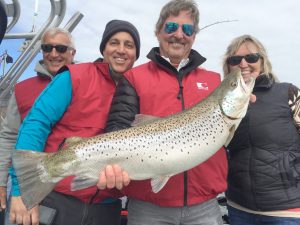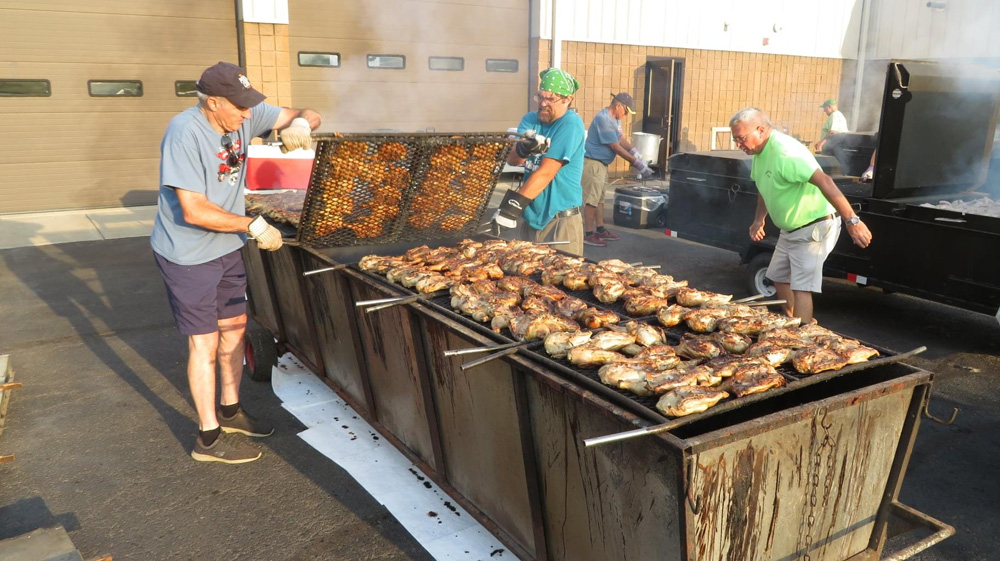Brownies anyone?
Lake Ontario is the best place in the country to catch big brown trout. Western New York fishermen have a good chance to catch a trophy brown trout right here on our swollen shorelines of the big lake.
I contacted Captain Jeremy Sage of JDSCustomCharters.com for some tips for targeting Godzilla brown trout and the man was gracious enough to divulge his secret.
He explained, “Right after first ice out is the prime time to target browns along the shoreline of Lake Ontario. As the lake warms up, usually 38 to 40 degrees by the end of March, these fish will leave the creeks and rivers, moving along the shoreline to where they can find warmer water and a food supply. They will often congregate around river mouths where the warmer river water meets the lake water. Fishing for hungry browns can be fast and furious, with double and triple-headers not uncommon.

Pam Powley schools the guys on how to land big browns. Provided photo
“At this time of year, you don’t need an expensive charter boat with lots of equipment to catch these fish. Frequently, smaller boats in the 16 feet range will catch just as many fish because of their stealth. If you have a couple of fishing rods rigged with 12 to 15 pound test fishing line and a handful of Rapala minnow baits, you can have a field day. Cast them out behind the boat about 60 to 100 feet and motor the shoreline. Shore fisherman as well can enjoy great action casting from shore near river mouths or off of local piers.”
Jeremy goes on to say, “when I get out on Lake Ontario for the first trip of the year, I am looking at a couple things that will increase my odds of catching versus just fishing. The first is watching my temperature gauge. I am searching for the warmest water, which is usually stained/off colored. I am not looking for muddy water, but water that has some coloration and is not crystal clear. With a good set of polarized glasses, you will be able to see the line or edges between two different areas of colored water.
“If you can find that scenario along the shoreline in 10 to 15 feet of water, that is where you will find Mr. Brown Trout and his family. The bigger brown trout can be mixed in with average sized fish or located in a touch deeper water. If you pay attention to the details you might even land a true Lake Ontario trophy.
“When I target these fish for charter customers I keep my speed down to around 2 to 2.5 miles per hour; this is read off of my GPS. I try to go as slowly as possible, but experiment until I get my first bite.
“When I am picking out lures, I have to consider how colored the water is and if it is cloudy or sunny. If it is cloudy or overcast skies, I choose brighter colors: bright reds, yellows and fire tiger patterns will be going for a swim. If it is sunny and the water is not too stained up, I will send out natural-colored baits to mimic baitfish: black and silvers, blue and silver, brown and gold.
“One of the brown trout’s favorite snacks is the goby. These bottom-dwelling critters have a brown back and lighter copper brown sides with a white belly. If you can find a minnow bait or stick bait that imitates that, you are in business.
“These lures are typically 3 to 5 inches long and are tied on the end of a 10 foot piece of fluorocarbon fishing line for a leader with a small swivel snap. The fluorocarbon is invisible in the water and adds another layer of stealth to your approach when fishing so shallow.
“Once the baits are picked out, put them in the water and let line out off the back of the boat, starting around 100 feet back. Ideally you have line counters on your reels, but if not cast them out plus some extra line. The big thing you need to remember is how far it was out if you catch a fish so you could duplicate that the next time and catch another.
“Now that your lures are out, we use planer boards to get the baits out to the side and away from the boat. Think of a planer board as a bobber that can steer your bait away from the boat noise. A common planer board is the Church Board, easy to hook your line to and easy to see when 50-75 feet away from your boat.
“Another tactic to use is fishing downriggers. This is an easy way to get your bait to a certain depth by way of a weight and a lure release. It is common to run two or three downriggers in April and May with a lure called a spoon.
“The same rules apply when picking out the millions of color combinations out there from spoon manufacturers. These are sent out 30 to 50 feet, attached to the downrigger release and fished a couple feet under the surface to a few feet off the bottom, depending on how deep you are.
“Once you are all set up, steer your boat along the shoreline, taking some small turns in and out, changing the speed off and on as you go. Experiment with changing lure colors and types until you start catching. Once you catch a few fish, pay attention to the lures/lines that they hit and try and duplicate them on your other rods.”
As a charter captain, Jeremy is extremely knowledgeable and works his tail off to put his clients on fish. You can contact him at Captain Jeremy Sage at www.JDSCustomCharters.com or 734-8930.



